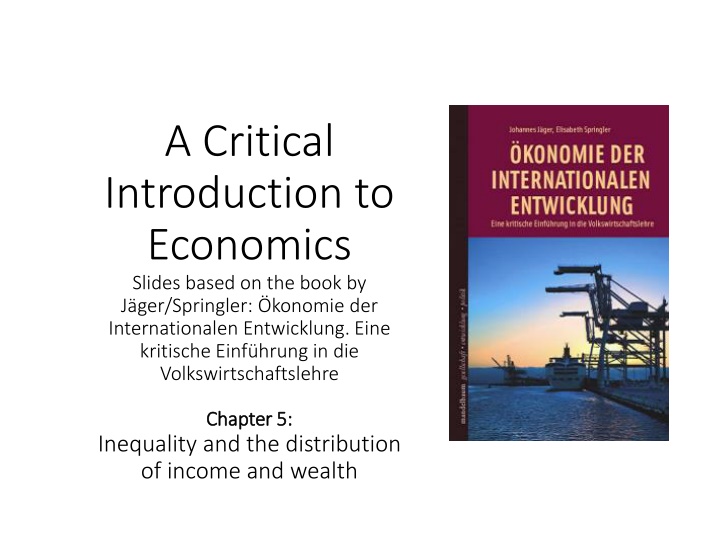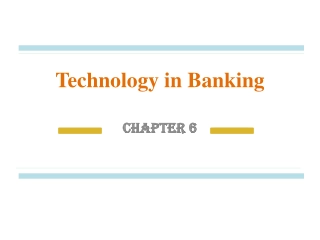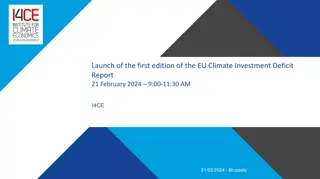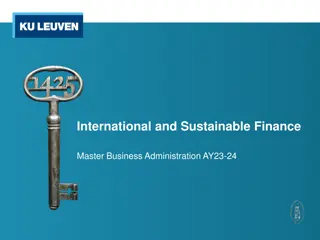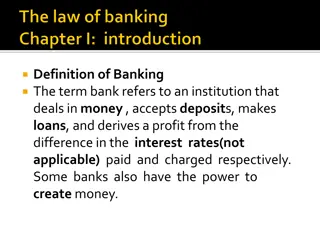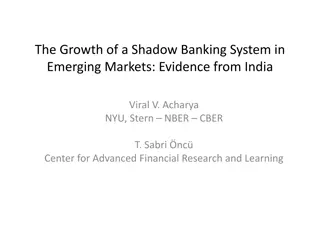5th Webinar on Banking, Finance & Investments – Fundamental Review of FRTB Standardized Approach
This webinar on banking, finance, and investments focuses on the Fundamental Review of the Trading Book (FRTB) Standardized Approach with insights from Harshit Gupta, Executive Director at Acies Consulting LLP. The agenda includes an overview of market risk, capital requirements under Basel, and in-depth discussions on trading book boundaries and risk assessment approaches. The speaker will delve into market risk drivers, sources, and management strategies for financial institutions, providing valuable knowledge for professionals in the industry.
Download Presentation

Please find below an Image/Link to download the presentation.
The content on the website is provided AS IS for your information and personal use only. It may not be sold, licensed, or shared on other websites without obtaining consent from the author.If you encounter any issues during the download, it is possible that the publisher has removed the file from their server.
You are allowed to download the files provided on this website for personal or commercial use, subject to the condition that they are used lawfully. All files are the property of their respective owners.
The content on the website is provided AS IS for your information and personal use only. It may not be sold, licensed, or shared on other websites without obtaining consent from the author.
E N D
Presentation Transcript
A Critical Introduction to Economics Slides based on the book by J ger/Springler: konomie der Internationalen Entwicklung. Eine kritische Einf hrung in die Volkswirtschaftslehre Chapter 5: Chapter 5: Inequality and the distribution of income and wealth
Inequality and Distribution Personal distribution of income and wealth (Gini coefficient): increasing inequalities Functional distribution of income: increasing profit share Primary and secondary distribution of income (redistribution by the state reduces inequality) Inequality and distribution in different paradigms: Neoclassical economics Keynesianism Political economy
5.1.1 Neoclassical Neoclassical economics economics: general approach Theory of marginal productivity explains income (and therefore distribution) Differences in personal income due to different endowment of resources Assumes a given distribution of factors of production (and homogenous capital)
5.1.2 Key-concepts in neoclassical economics (1) Foundations of neoclassical welfare economics (2) Welfare analysis, implications of state intervention
(1) Foundations of neoclassical welfare economics Basic assumption: Utility cannot be compared between individuals Pareto criteria Pareto optimum Consumer surplus Producer surplus
(2) Welfare analysis, implications of state intervention Market equilibrium maximises welfare (sum of CS and PS) State intervention reduces the quantity traded welfare loss
5.1.3 Implications for economic policy Market income (and therefore income distribution) is Pareto-optimal State intervention (taxes on goods, price ceilings etc.) lead to a welfare loss but tax revenues are needed: Liberalism with a human face Poll tax Ramsey taxes
5.2.1 Keynesianism Keynesianism: general approach Critique of neoclassical marginal productivity theory to explain the distribution of income Determination of wages labour market is not a normal market but demand depends on profit expectations of firms (investment) Accumulation of capital and interest rates Interest rates determined in financial markets (liquidity preference theory)
5.2.2 Key-concepts in Keynesianism Interest rate crucial for functional distribution of income Real wages depend on structures and monopoly rents at the goods market MPC is different for wages and profits Workers spend what they earn Capitalists earn what they spend (due to the multiplier effect)
5.2.3 Implications for economic policy State should redistribute income and wealth (inheritance tax) from capital to labour and high income earners to low income earns increases demand and therefore output (due to different MPC) Decrease the interest rate in order to obtain full employment
5.3.1 Political Economy Political Economy: general approach Inequality is an expression of social relations of production and reproduces them Capitalism implies a very unequal distribution of wealth and income The distribution of income and wealth is contested Wealth is produced by labour Capital is not a thing or productive but a social relation
5.3.2 Key-concepts in Political Economy (1) Determination of primary income distribution (2) Historical modes of production and distribution (3) The international and material dimension of inequality (4) Distribution and growth dynamics (5) Redistribution by the State
(1) Determination of primary income distribution Labour saving technical progress (reserve army) Tendency that wages are determined by societal subsistence level Contesting the level of the surplus value (and therefore the wage) within (or by changing) the wage relation Absolute surplus value Relative surplus value
(2) Historical modes of production and distribution Liberal / competitive wage relation (-1914) Stagnating wages Fordist wage relation (1945-1970) Institutionalized compromise Increasing wages with productivity Neo-liberal wage relation (1980- Erosion of Fordist wage relation Stagnating/decreasing wages
(3) The international and material dimension of inequality Low wages in the periphery = higher wages and / or profits in the core of the world economy Conflicts about the use of natural resources (material dimension): global oligarchic vs. democratic well-being
(4) Distribution and growth dynamics Higher wages (redistribution of income) functional for intraverted growth models Overaccumulation (due to over-exploitation) has caused recent economic crisis Higer wages would be functional for an intensive dynamic growth regime
(5) Redistribution by the State Fiscal policy (taxes, government spending) is at the centre of (class) conflict Modern welfare state redistributes mainly within working class Redistribution by the State reduces inequality substantially
5.3.3 Implications for economic policy (Class) struggle over distribution of primary and secondary income and wealth New distributional patterns during periods of crisis (related to the specific mode of production resp. regime of accumulation) Reduction of inequality as a central goal Philosophical debates as instruments for struggle Reduction of inequality in income, wealth and other multiple forms of inequality Lower degree of inequality is important for more democratic structures (instead of oligarchic structures) Measures to reduce inequality Modify the wage relation (primary income distribution), balanced job complexes Increase redistributive function of the state (secondary income distribution)
